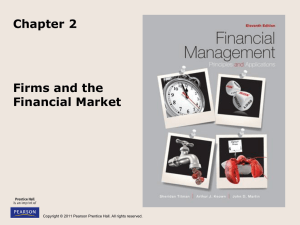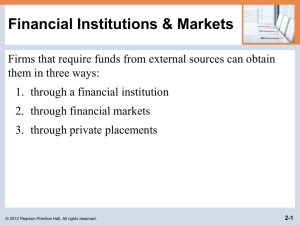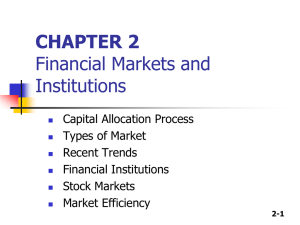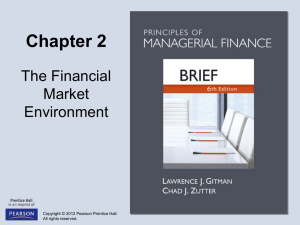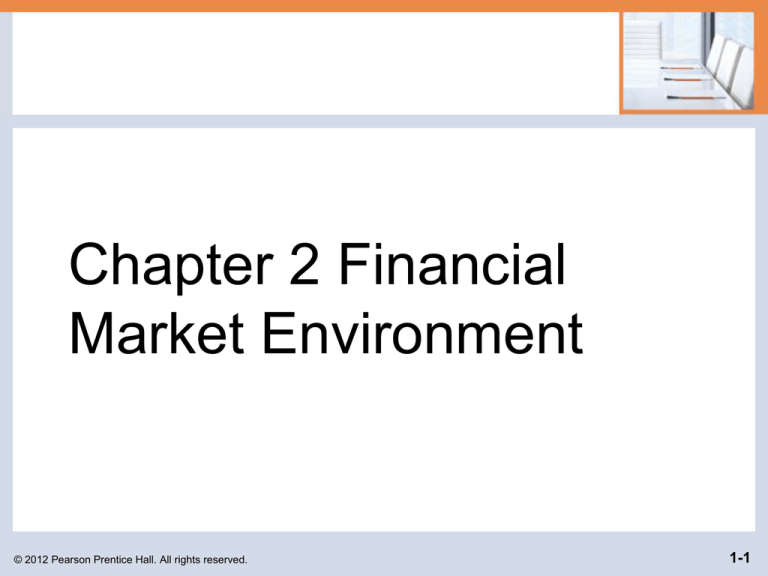
Chapter 2 Financial
Market Environment
© 2012 Pearson Prentice Hall. All rights reserved.
1-1
Financial Institutions & Markets
Firms that require funds from external sources can obtain
them in three ways:
1. through a financial institution
2. through financial markets
3. through private placements
Financial institutions are intermediaries that
channel the savings of individuals, businesses, and
governments into loans or investments.
© 2012 Pearson Prentice Hall. All rights reserved.
2-2
Commercial Banks, Investment Banks,
and the Shadow Banking System
• The Glass-Steagall Act was an act of Congress in 1933
that created the federal deposit insurance program and
separated the activities of commercial and investment
banks.
– Repealed in the late 1990s.
• The shadow banking system describes a group of
institutions that engage in lending activities, much like
traditional banks, but these institutions do not accept
deposits and are therefore not subject to the same
regulations as traditional banks.
© 2012 Pearson Prentice Hall. All rights reserved.
2-3
Financial Institutions &
Markets: Financial Markets
• Financial markets are forums in which suppliers of funds
and demanders of funds can transact business directly.
• Transactions in short term marketable securities take place
in the money market while transactions in long-term
securities take place in the capital market.
• A private placement involves the sale of a new security
directly to an investor or group of investors.
• Most firms, however, raise money through a public
offering of securities, which is the sale of either bonds or
stocks to the general public.
© 2012 Pearson Prentice Hall. All rights reserved.
2-4
Financial Institutions & Markets:
Financial Markets (cont.)
• The primary market is the financial market in which
securities are initially issued; the only market in which the
issuer is directly involved in the transaction.
• IPO
• Seasoned Shares
• Only time issuer gets funds from investors
• Secondary markets are financial markets in which preowned securities (those that are not new issues) are traded.
© 2012 Pearson Prentice Hall. All rights reserved.
2-5
Markets
• The money market is created by a financial relationship
between suppliers and demanders of short-term funds.
• marketable securities
• among the least risky investments available.
• The capital market is a market that enables suppliers and
demanders of long-term funds to make transactions.
• The key securities are bonds and both common and preferred
stock.
© 2012 Pearson Prentice Hall. All rights reserved.
2-6
Focus on Practice
Berkshire Hathaway – Can Buffett Be Replaced?
– Since the early 1980s, Berkshire Hathaway’s Class A common
stock price has climbed from $285/share to $114,000/share.
– The company is led by Chairman Warren Buffett (80) and ViceChairman Charlie Munger (86).
– The share price of BRKA has never been split. Why might the
company refuse to split its shares to make them more affordable
to average investors?
© 2012 Pearson Prentice Hall. All rights reserved.
2-7
Broker Markets and
Dealer Markets
Broker markets are securities exchanges on which the two
sides of a transaction, the buyer and seller, are brought
together to trade securities.
– Trading takes place on centralized trading floors.
– NYSE
Dealer markets are markets in which the buyer and seller
are brought together indirectly via computers
– no centralized trading floors.
– The Nasdaq market is one example
– OTC
© 2012 Pearson Prentice Hall. All rights reserved.
2-8
The Role of Capital Markets
• From a firm’s perspective, the role of capital markets is to be a liquid
market where firms can interact with investors in order to obtain
valuable external financing resources.
• From investors’ perspectives, the role of capital markets is to be an
efficient market that allocates funds to their most productive uses.
• An efficient market allocates funds to their most productive uses as
a result of competition among wealth-maximizing investors and
determines and publicizes prices that are believed to be close to their
true value.
© 2012 Pearson Prentice Hall. All rights reserved.
2-9
Exchanges
• NYSE
• http://www.youtube.com/watch?v=TPUDPhpCec
A&feature=player_detailpage
• CBOE
• http://www.youtube.com/watch?v=_UXomMnQK
T4&feature=player_detailpage
© 2012 Pearson Prentice Hall. All rights reserved.
2-10
Focus on Ethics
The Ethics of Insider Trading
– Martha Stewart was convicted of conspiracy, obstruction, and making false
statements to federal investigators and served 5 months in jail, 5 months of
home confinement, 2 years of probation, and a $30,000 fine.
– Laws prohibiting insider trading were established in the United States in the
1930s. These laws are designed to ensure that all investors have access to
relevant information on the same terms.
– However, many market participants believe that insider trading should be
permitted.
– If efficiency is the goal of financial markets, is allowing or disallowing
insider trading more unethical?
– Does allowing insider trading create an ethical dilemma for insiders?
© 2012 Pearson Prentice Hall. All rights reserved.
2-11
The Financial Crisis: Financial
Institutions and Real Estate Finance
• Securitization is the process of pooling mortgages or
other types of loans and then selling claims or securities
against that pool in a secondary market.
• Mortgage-backed securities represent claims on the cash
flows generated by a pool of mortgages and can be
purchased by individual investors, pension funds, mutual
funds, or virtually any other investor.
• A primary risk associated with mortgage-back securities is
that homeowners may not be able to, or may choose not to,
repay their loans.
© 2012 Pearson Prentice Hall. All rights reserved.
2-12
Regulation of Financial Institutions and Markets:
Regulations Governing Financial Institutions
• The Glass-Steagall Act (1933) established the Federal Deposit
Insurance Corporation (FDIC) which provides insurance for
deposits at banks and monitors banks to ensure their safety and
soundness.
• The Glass-Steagall Act also prohibited institutions that took deposits
from engaging in activities such as securities underwriting and
trading, thereby effectively separating commercial banks from
investment banks.
© 2012 Pearson Prentice Hall. All rights reserved.
2-13
Regulation of Financial Institutions and Markets:
Regulations Governing Financial Markets
• The Securities Act of 1933 regulates the sale of securities to the
public via the primary market.
– Requires sellers of new securities to provide extensive disclosures to the
potential buyers of those securities.
• The Securities Exchange Act of 1934 regulates the trading of
securities such as stocks and bonds in the secondary market.
– Created the Securities Exchange Commission, which is the primary
government agency responsible for enforcing federal securities laws.
– Requires ongoing disclosure by companies whose securities trade in
secondary markets (e.g., 10-Q, 10-K).
– Imposes limits on the extent to which “insiders” can trade in their firm’s
securities.
© 2012 Pearson Prentice Hall. All rights reserved.
2-14
Business Taxes
• Both individuals and businesses must pay taxes on income.
• The income of sole proprietorships and partnerships is taxed as the
income of the individual owners, whereas corporate income is
subject to corporate taxes.
• Both individuals and businesses can earn two types of income—
ordinary income and capital gains income.
• Under current law, tax treatment of ordinary income and capital
gains income change frequently due frequently changing tax laws.
© 2012 Pearson Prentice Hall. All rights reserved.
2-15
Table 2.1
Corporate Tax Rate Schedule
© 2012 Pearson Prentice Hall. All rights reserved.
2-16
Business Taxes:
Ordinary Income
Ordinary income is earned through the sale of a firm’s goods
or services and is taxed at the rates depicted in Table 2.1 on
the previous slide.
Example
Weber Manufacturing Inc. has before-tax earnings of $250,000.
Tax = $22,500 + [0.39 ($250,000 – $100,000)]
Tax = $22,500 + (0.39 $150,000)
Tax = $22,500 + $58,500 = $80,750
© 2012 Pearson Prentice Hall. All rights reserved.
2-17
Business Taxation: Marginal
versus Average Tax Rates
• A firm’s marginal tax rate represents the rate at which
additional income is taxed.
• The average tax rate is the firm’s taxes divided by taxable
income.
Example
What are Webster Manufacturing’s marginal and average tax rates?
Marginal Tax Rate
= 39%
Average Tax Rate
= $80,750/$250,000 = 32.3%
© 2012 Pearson Prentice Hall. All rights reserved.
2-18
Calculate corporate taxes
Taxable income = 78,000
13,750 + .34 * 3,000 = 14,770
Average tax rate = 14,770 / 78,000 = 18.9%
Marginal tax rate = 34%
Taxable income = 17,000,000
5,150,000 + .38 * 2,000,000 = 5,910,000
Average tax rate = 5,910,000 / 17,000,000 = 34.7%
Marginal tax rate = 38%
© 2012 Pearson Prentice Hall. All rights reserved.
2-19
Business Taxation:
Interest and Dividend Income
• For corporations only, 70% of all dividend income
received from an investment in the stock of another
corporation in which the firm has less than 20% ownership
is excluded from taxation.
• This exclusion moderates the effect of double taxation,
which occurs when after-tax corporate earnings are
distributed as cash dividends to stockholders, who then
must pay personal taxes on the dividend amount.
• Unlike dividend income, all interest income received is
fully taxed.
© 2012 Pearson Prentice Hall. All rights reserved.
2-20


